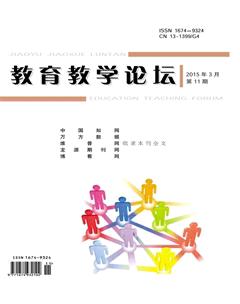图式理论在高中英语阅读教学中的应用
覃婧

摘要:在高中新课改的推动下如何进行有效的英语阅读教学是当前备受关注的话题。本文通过教学实际案例探讨了图式理论在高中英语阅读教学中的应用,对提高学生的阅读能力是行之有效的。
关键词:图式理论;语言图式;内容图式;形式图式;英语阅读教学
中图分类号:G642.41 文献标志码:A 文章编号:1674-9324(2015)11-0270-03
一、图式理论概述
概括地说,图式就是存在于人头脑中已有的知识单位,就阅读而言,按照F.C Barlette提出的理论,图式可分成三种类型:①语言图式,指读者已有的有关语音、词汇和语法等方面的语言知识,是对构成文章的语言基本要素的掌握程度及运用能力。②内容图式,指读者对文章的内容、背景和主题的熟悉程度。③形式图式,指读者对阅读材料的体裁和篇章结构的了解程度。在这三种图式中,语言图式是内容图式和形式图式的基础,即理解文章的基础,内容图式是理解文章内容的依据,为理解文章内容提供向导,形式图式则是调用内容图式的能力,形成正确的结构图以提高对文章的理解,三者相辅相成,交互作用,缺一不可。
二、图式理论在高中英语阅读教学中的应用
阅读过程就是利用已有的图式对阅读材料的一个不断地选择、检验、整理与加工并选择和调整信息的过程。因此,在高中英语阅读教学中应做到:阅读前,充分发挥图式的预测推理功能,利用插图、标题和文章的结构进行相关的内容预测;阅读中,充分发挥图式的信息处理功能,利用关键词及阅读基本技能skimming,scanning,careful reading了解文章的基本结构,并进行深层次的理解;阅读后,充分发挥图式的巩固记忆功能,通过画语义图,让学生在视觉上有一个清晰的轮廓以便记忆进行复述课文、写作等活动。
教学案例:对人教版高三教材选修九Unit1Breaking Records “The Road is Always ahead of You”的教学设计与反思。
教材分析:本篇课文的主题是“路永在前方”,介绍了拥有多项世界吉尼斯世界纪录的传奇人物阿什里塔·弗曼,一个非职业运动员却取得了许多职业运动员无法企及的成就。本节课通过他的成长经历以及获得这些成就的精神动力,激励学生认识自我的潜力,找到精神动力的源泉,实现梦想。
教学目标:①在阅读中初步掌握本单元生词、词组及句型的用法,同时领悟作者如何进行内容安排,把握其主题,了解写作意图。②让学生在阅读中掌握速读、跳读、精读等技能,遇到障碍时要调整心态和注意力。③了解吉尼斯纪录的相关知识和这些纪录创造者应具备的品质,促使学生摈弃“我不行”的心理暗示,让意念统领身体走出一条成功之路。
教学重难点:依据记叙文的特点指导阅读,训练学生skimming,scanning,careful reading等技能,再对文章进行深层次的分析去评价主人公,并构建相关的图式,然后利用所构建的图式使学生能够在理解的基础上复述课文,作为书面表达的材料以巩固课文,有利于建立新图式。
教学手段:以教材为依托,利用现代多媒体手段结合传统教学,呈现整个教学过程。
教学步骤:
Step 1 Lead-in——利用图片组织讨论激活已有图式
Show students the pictures of some famous athletes which are taken at the end of the events.Have a discussion about how they feel and what they have in common.
1.Question:Who are the athletes in the pictures?
2.Group discussion:What may they be saying in their minds after they make it?What do they have in common to become successful world record holders?
Possible answers:I've got it!I know I can do it!It's hard to believe I made it!I've done my best …/Concentration,determination,devotion,diligence,enthusiasm,fitness,good physical abilities,hard training,perseverance,self-confidence,skills,strong will…
教学反思:本环节引导学生看图并讨论来激发学生的积极性,运用已有的背景知识激活已有图式。通过讨论,学生不但对杰出运动员的事迹有所了解,而且明白了他们之所以杰出的秘诀,拥有良好的心理素质及挑战自我的决心和毅力是最重要的,因此更容易理解“只要拥有所有这些要素,任何一个普通人都可能成为记录的创造者”(With all these qualities,anyone can be a record holder),逐步将学生引入阅读话题,激发学生想要通过阅读以了解更多相关话题的兴趣,为下一步教学铺平道路。
Step 2 Pre-reading——介绍背景知识扩充语言图式和丰富内容图式
Show students the pictures that will be talked about in the text.First,make them learn about each activity and how to do it; then ask them to experience one or more of this and have a discussion about what is needed to do these activities that seem not very serious.
1.Question:What is each person doing in the pictures?Do you know the names of the activities?
2.Class activities:Ask several students to act one or more of these activities,such as jumping jacks to see how they think of them.
3.Group discussion:①Would you like to try any of them?Do you think you are fit to do them? ②Do you think you could do any of them for any length of time?
4.Look at the title and pictures to predict what will be mainly talked about in the passage.
教学反思:本环节让学生借助图片了解运动的名称及其方式,再让学生体验其中一项或几项运动,并思考讨论所需要的身体技能。每种活动所要求的身体素质都不完全一样,但所要求的心理素质是基本相通的,即concentration,strong will,devotion等。这种由浅入深的方式,使学生从感性认识上升为理性思考,了解了文章提及的运动项目,从而引入本文的背景知识,即扩充了学生的语言图式,又丰富了他们的内容图式,同时降低阅读难度,再根据标题和图片进行预测文章内容,为下一步阅读理解做好充分的准备。
Step 3 While-reading——着重语篇理解构建形式图式
1.Skimming:Quickly glance through the text and tick the topics about Ashrita that the author does not cover.①physical skills needed for events ② number of records broken ③how and why he became a sportsman ④kind of records broken ⑤ his appearance ⑥his family life ⑦ his place and date of birth ⑧his occupation
⑨ his education ⑩ his first Guinness record.
2.Scanning:Go through the text again to find out the answers to the questions:①Who is Ashrita Furman?Is he a natural athlete?②Who helped him build confidence to be a sportsman?③What is required to do these activities?④When and why did he enter the Guinness book of world records?
When dealing with the questions,tell students how to use some key words to get the answers quickly,such as while,yet and so on,and also help students solve language obstacles,such as in reality,unfit,meditation and so on.
3.Careful reading:Read the first two paragraphs carefully to get the answers to the questions:①Has he broken records in all seven continents?②How many records has he broken?
Then read from the third to seventh paragraph to get the information about what physical difficulties he has experienced when doing these activities?A.walking with a bottle of milk on his head B.standing on top of a Swiss ball C.somersaulting D.doing gymnastically correct lunges
Last,try to get how Ashrita came to be a sportsman and his beliefs as well,knowing how and when he ran into and entered the Guinness World Records so that students can make clear his motivation of challenging the Guinness World Records.In addition,have a guess about where he lives now and how old he is according to the text.Meanwhile,the teacher shows a semantic mapping to help students better understand the text.
After getting the main structure of the whole text,ask students to do some reading exercises-choose the best choices.
(1)Which kind of activity is most likely to make a person dizzy?
A.Standing on top of a 75cm Swiss ball
B.Jumping jacks
C.Doing gymnastically correct lunges
D.Somersaulting
(2) Which is NOT the reason why Ashrita became a successful sportsman?
A.He was very weak as a child,so he had to take more exercise.
B.He became one of Sir Chinmoy's students.
C.Ashrita entered the marathon and won much confidence.
D.He refused to accept any physical limitation.
(3)The underlined word “fascinate”means .
A.annoy B.attract C.amaze D.attack
(4)The passage mainly tells us .
A.how Ashrita became famous
B.how Ashrita became a sportsman
C.Ashrita enjoys the challenge of breaking Guinness records
D.why Ashrita got crazy about sports
教学反思:本环节引导学生在扩充语言图式和丰富内容图式之后进行语篇理解,并形成相应的形式图式。根据新课程理念,首先让学生快速把握文章结构要点,从整体明白文章大意。然后细读文章,找准相关细节信息加深对文章的理解,告诉他们如何利用关键词迅速找寻特定信息,期间出现的困难词汇及短语,培养学生根据上下文进行猜测的能力。随后为学生提供视觉上的结构语义图,就更容易利用关键词建立起文章的形式图式,利于学生理清思路,深层理解语篇,为复述课文做好充分的准备。同时,还设计了高考阅读理解题目,看是否达到了预期的阅读效果。
Step 4 Post-reading——巩固和运用图式
1.Class work:Try to play relay in retelling the text one by one according to the structure shown on the screen.
2.Group work:Have a discussion about Ashrita's motivation and beliefs.①Why did Ashrita keep on challenging different Guinness World Records instead of taking part in the Olympic Games?②Why did he participate in unconventional and funny sports rather than conventional and competitive ones?③Why did Ashrita do active sports after learning quiet mediation?④What are his beliefs? Do you agree?
教学反思:本环节组织学生依据已知图式对课文进行复述,巩固和运用在本课中形成的图式,一方面,帮助学生记忆所学内容,培养语言运用能力,让基础较差的学生通过接龙的方式积极参与活动,激发他们的兴趣;另一方面,讨论主人公的动机和信念,了解他身上具备的品质,促使学生摈弃“我不行”的心理暗示,让意念统领身体走出一条成功之路。
Step 5 Summary and Homework ——发展建立新图式
1.There are only some cartoons about Ashrita in the text,so students can imagine the outlook of Ashrita.
2.Write a composition about what he says,“There is only one perfect road.It is ahead of you,always ahead of you”,taking students' daily life for example based on the standards from the college entrance examination in Hubei.If possible,search as much information about Ashrita as possible on the Internet after class.
教学反思:本环节先总结本课所学,再让学生想象主人公的外在形象,并根据他的事迹完成半开放式作文,发展建立新图式,为下一次学习提供相关的图式。
三、教学效果与反思
总之,这堂阅读课思路清晰,课堂设计合理,学生思维活跃,取得了很好的教学效果。这说明图式理论对高中英语阅读教学中具有指导和实践意义,不仅有助于学生对语言的理解,还有助于增强学生的阅读意识,扩大学生的背景知识,构建学生的图式结构,提高学生的阅读能力。因此,笔者认为,教师用图式理论指导阅读教学从而提高学生的阅读能力是行之有效的。
参考文献:
[1]Bartlett,E.C.Remembering:A Study in Experimental and Social Psychology[M].Cambridge:Carmbridge University Press,1932.
[2]Brown,GillianandGeorge,Yule.Discourse Analysis[M].Beijing:Foreign Language Teaching and Research Press,2000.
[3]李蓉霞.图式理论在高中英语新课程阅读课中的运用[J].考试·教研,2006.
[4]何广锵.英语教学研究[M].广州:广东高等教育出版社,2002.
[5]郭霞.图式理论在高中英语阅读中的应用[J].牡丹江教育学院学报,2005,(1).

